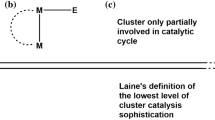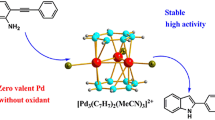Abstract
The historical background of and the incentive for using ruthenium carbonyl clusters as homogeneous catalysts are outlined. Keeping in view the possible solutions the uncertainties arising from declusterification and metal colloid formation are discussed. All ruthenium cluster-catalysed reactions are broadly classified as reactions with or without carbon monoxide as one of the reactants and the basic differences between such reactions are highlighted. Some of the factors of special relevance to cluster-catalysed reaction systems are mentioned. The reactions involving carbon monoxide are then discussed. These include water-gas-shift reaction, carbon monoxide hydrogenation, hydroformylation, reductive carbonylation of nitrobenzene and other carbonylation reactions. Hydrogenation, transfer hydrogenation, isomerisation and a few other reactions are then discussed. For all these reactions, special emphasis is laid on well-characterised cluster complexes that have been proposed as catalytic intermediates. Finally an attempt has been made to identify the path that future research in cluster catalysis is likely to follow.
Similar content being viewed by others
References
Adams R D, Babin J E and Kim H S 1987J. Am. Chem. Soc. 109 1414
Adams R D, Kim H S and Wang S 1985J. Am. Chem. Soc. 107 6107
Alper H and Amaratunga S 1980Tetrahedron Lett. 21 2603
Alper H and Hashem K E 1981J. Am. Chem. Soc. 103 6514
Alper H and Paik N H 1978Nouv. J. Chim. 2 245
Andrianary P, Jenner G, Libs S and Teller G 1987J. Mol Catal. 39 93
Anstock M, Taube T, Gross D C and Ford P C 1984J. Am. Chem. Soc. 106 3696
Arduini A A, Bahsoun A A, Osborn J A and Voelkar C 1980Angew. Chem. Int. Ed. Engl. 19 1024
Basu A, Bhaduri S and Khwaja H 1987aJ. Organomet. Chem. 53 C28
Basu A, Bhaduri S, Khwaja H, Jones P G, Schroder T and Sheldrick G M 1985J. Organomet. Chem. 290 C19
Basu A, Bhaduri S, Khwaja H, Sapre N, Sharma K, Jones P G and Carpenter G B 1989 (to be published)
Basu A, Bhaduri S, Sharma K and Jones P G 1987bJ. Chem. Soc, Chem. Commun. 1126
Basu A, Bhaduri S, Sharma K and Jones P G 1987cJ. Organomet. Chem. 328 C34
Basu A and Sharma K R 1986J. Mol. Catal. 38 315
Bergounhov C, Bonnet J J, Fompeyrine P, Lavigne G, Lugan N and Mansilla F 1986Organometallics 5 60
Bhaduri S, Gopalakrishnan K S, Sheldrick G M, Clegg W and Stalke D 1983J. Chem. Soc, Dalton Trans. 2339
Bhaduri S, Khwaja H and Jones P G 1988J. Chem. Soc, Chem. Commun. 194
Bhaduri S and Sharma K 1988J. Chem. Soc, Chem. Commun. 173
Bitsi G and Jenner G 1987aJ. Mol. Catal. 40 71
Bitsi G and Jenner G 1987bJ. Organomet. Chem. 330 429
Bianchi M, Matteoli U, Frediani P, Menchi G and Piacenti F 1982aJ. Organomet. Chem. 236 375
Bianchi M, Matteoli U, Frediani P, Menchi G and Piacenti F 1982bJ. Organomet. Chem. 240 59
Bianchi M, Matteoli U, Menchi G, Frediani P and Piacenti F 1982cJ. Organomet. Chem. 240 65
Bianchi M, Matteoli U, Menchi G, Frediani P, Pratesi S, Piacenti F and Botteghi C 1980J. Organomet. Chem. 198 73
Blum Y and Laine R M 1986Organometallics 5 2081
Blum Y and Shvo Y 1984J. Organomet. Chem. 263 93
Bradley J S 1979J. Am. Chem. Soc. 101 7419
Bricker J C, Bhattacharyya N and Shore S G 1984Organometallics 3 201
Bricker J C, Nagel C C, Bhattacharyya A A and Shore S G 1985J. Am. Chem. Soc. 107 377
Bruce M I, Guss J M, Mason R, Skelton B W and White A H 1983J. Organomet. Chem. 251 261
Bruce M I, Kehoe D C, Matisons J G, Nicholson B K, Rieger P H and Williams M L 1982J. Chem. Soc,Chem. Commun. 442
Castiglioni M, Giardano R and Sappa E 1988J. Organomet. Chem. 342 111
Cenini S, Crotti C, Pizzotti M and Porta F 1988J. Org. Chem. 53 1243
Cenini S, Pizzotti M, Crotti C, Porta F and LaMonica G 1984J. Am. Soc, Chem. Commun. 1286
Chen M J, Feder H M and Rathke J W 1982J. Am. Chem. Soc. 104 7346
Choi H W and Muetterties E L 1981Inorg. Chem. 20 2664
Churchill M R, Hollander F J and Hutchinson J P 1977Inorg. Chem. 16 2655
Collman J P, Brauman J I, Tustin G and Wann G S III 1983J. Am. Chem. Soc 105 3913
Collman J P and Hegedus L S 1980Principles and applications of organotransition metal chemistry (Mill Valley, Ca: University Science Books) p. 4
Collman J P, Kosydan K M, Bressan M, Lamanna W and Garrett T 1984J. Am. Chem. Soc. 106 2569
Darensbourg D J, Gray R L and Ovalles C 1987J. Mol. Catal. 41 329
Darensbourg D J, Ovalles C and Pala M 1983J. Am. Chem. Soc. 105 5937
Daroda R J, Blackborow, J R and Wilkinson G 1980J. Chem. Soc, Chem. Commun. 1101
Demitras G C and Muetterties E L 1977J. Am. Chem. Soc. 99 2796
Des Abayes H and Alper H 1977J. Am. Chem. Soc. 99 98
Dombeck B D 1980J. Am. Chem. Soc. 102 6855
Dombeck B D 1981J. Am. Chem. Soc. 103 6508
Dombeck B D 1983aJ. Organomet. Chem. 250 467
Dombeck B D 1983bAdv. Catal. 22 325
Dombeck B D and Harrison A M 1983J. Am. Chem. Soc. 105 2485
Doi Y, Tamura S and Koshizuke K 1983J. Mol. Catal. 19 213
Elpattenier F L, Matthys P and Calderazzo F 1970Inorg. Chem. 9 342
Evans J and Jingxing G 1985J. Chem. Soc, Chem. Commun. 39
Fjare D E, Jensen J A, Gladfelter W L 1983Inorg. Chem. 21 1774
Ford P C and Rokicki A 1988Adv. Organomet. Chem. 28 139
Foulds G A, Johnson B F S and Lewis J 1984J. Organomet. Chem. 296 147
Geoffroy G L and Bassner S L 1988Adv. Organomet. Chem. 28 1
Gladfelter W L and Geoffroy G L 1980Adv. Organomet. Chem. 18 207
Gross D C and Ford P C 1985J. Am. Chem. Soc. 107 585
Graft J L and Wrighton M S 1980J. Am. Chem. Soc 102 2123
Haggin J 1982Chem. Eng. News 60(6) 13
Han S H and Geoffroy G L 1986Organometallics 5 2561
Han S H, Geoffroy G L and Rheingold A L 1987aOrganometallics 6 2380
Han S H, Geoffroy G L and Rheingold A L 1987bInorg. Chem. 26 3426
Hidai M, Koyasu Y, Chikanari K and Uchida Y 1987J. Mol. Catal. 40 243
Hidai M, Onsaka M, Ye M, Koyasu Y, Kodama T and Uchida Y 1983Organometallics 2 292
Horwitz C P and Shriver D F 1984Adv. Organomet. Chem. 23 218
Huttner G and Knoll K 1987Angew. Chem., Int. Ed. Engl. 26 743
Island P, Denise B, Sneeden R P A, Cognion J M and Durual P 1982J. Organomet. Chem. 240 169
Jackson P F, Johnson B F G, Lewis J, McPartlin M and Nelson W J H 1978J. Chem. Soc, Chem. Commun. 920
Jenner G and Ardrianary P 1986J. Organomet. Chem. 307 263
Johnson B F G, Lewis J, Raithby P R and Suss-Fink G 1979J. Chem. Soc, Dalton Trans. 1356
Kampe C E, Boag N M, Knobler C B and Kaesz H D 1984Inorg. Chem. 23 1390
Kiso Y and Saeki K 1986J. Organomet. Chem. 303 C17
Kiso Y and Saeki K 1986J. Organomet. Chem. 309 C26
Kiso Y, Saeki K, Hayashi T, Tanaka M, Matsunaga Y, Ishino M, Tamura M, Deguchi T and Nakamura H 1987aJ. Organomet. Chem. 335 C27
Kiso Y, Saeki K and Tanaka M 1987bJ. Organomet. Chem. 329 99
Kiso Y, Tanaka M, Nakamura H, Yamasaki T and Saeki K 1986J. Organomet. Chem. 312 357
Knifton J F 1981aJ. Mol. Catal. 11 91
Knifton J F 1981bJ. Chem. Soc, Chem. Commun. 41
Knifton J F 1981cJ. Am. Chem. Soc. 103 3959
Knifton J F 1983aJ. Catal. 79 147
Knifton J F 1983bJ. Chem. Soc, Chem. Commun. 729
Knifton J F 1987J. Mol. Catal. 43 65
Knifton J F, Grisby R A Jr and Lin J J 1984Organometallics 3 62
Laine R M 1982J. Mol. Catal. 14 137
Laine R M and Crawford E J 1988J. Mol. Catal. 44 357
Laine R M, Thomas D W and Cary L W 1982J. Am. Chem. Soc. 104 1763
Lavigne, Kaesz H D 1984J. Am. Chem. Soc. 106 4647
Manchot W and Manchot W J 1936Z. Anorg. Allgem. Chem. 226 385
Mani D and Vahrenkamp H 1985J. Mol. Catal. 29 305
Marko L 1986 inMetal clusters in catalysis (eds) B C Gates, L Guczi and H Knozinger (Amsterdam: Elsevier)
Muetterties E L and Krause M J 1983Angew. Chem., Int. Ed. Engl. 22 135
Muetterties E L and Stein J 1979Chem. Rev. 79 479
Murata K, Matsuda A, Masuda T, Kiso Y and Saeki K 1987J. Mol. Catal. 42 389
Norton J R 1977 inFundamental research in homogeneous catalysis (eds) M Tsutsui and R Ugo (New York: Plenum Press)
Ono H, Hashimoto M, Fujiwara K, Sugiyama E and Yoshida K 1987J. Organomet. Chem. 331 387
Pittman C U Jr, Richmond M G, Absi-Halabi M, Benrich H, Richter F and Vahrenkamp H 1982Angew. Chem., Int. Ed. Engl. 21 786
Pursiainen J, Karjalainer K and Pakkanen T A 1986J. Organomet. Chem. 314 227
Rotem M and Shvo Y 1983Organometallics 2 1689
Sappa E and Milone L 1973J. Organomet. Chem. 61 383
Sasaki Y and Dixneuf P H 1986J. Chem. Soc. Chem. Commun. 790
Shvo Y, Blum Y, Reshef D and Menzin M 1982J. Organomet. Chem. 226 C21
Smieja J A, Gozum J E and Gladfelter W L 1986Organometallics 5 2154
Smieja J A, Gozum J E and Gladfelter W L 1987Organometallics 6 1311
Suss-Fink G 1982Angew. Chem., Int. Ed. Engl. 211 73
Suss-Fink G and Herrman G 1985J. Chem. Soc, Chem. Commun. 735
Suss-Fink G and Herrman G 1986Angew. Chem., Int. Ed. Engl. 25 570
Suss-Fink G, Herrman G and Thewalt U 1983Angew. Chem., Int. Ed. Engl. 22 880
Suss-Fink G and Reiner J 1981J. Organomet. Chem. 221 C36
Suss-Fink G and Reiner J 1982J. Mol. Catal. 16 231
Suss-Fink G and Schmidt G F 1987J. Mol. Catal. 42 361
Taube D J, Rokicki A, Anstock M and Ford P C 1987Inorg. Chem. 26 526
Tsuiji Y, Ohsumi T, Kondo T and Watanabe Y 1986J. Organomet. Chem. 309 333
Tsuiji Y, Yoshii S, Ohsumi T, Kondo T and Watanabe Y 1987J. Organomet. Chem. 331 379
Venalainen T, Iiskola E, Pursiainen J, Pakkanen T A and Pakkanen T T 1986J. Mol. Catal. 34 293
Wang H, Choi H W and Muetterties E L 1981Inorg. Chem. 20 2661
Warren B K and Dombeck B D 1983J. Catal. 79 334
Whyman R 1980 inTransition metal clusters (ed.) B F G Johnson (New York: John Wiley & Sons)
Whyman R 1983J. Chem. Soc, Chem. Commun. 1439
Williams G D, Geoffroy G L, Whittle G L and Rheingold A L 1985J. Am. Chem. Soc. 107 729
Williams G D, Whittle R R, Geoffroy G L and Rheingold A L 1987J. Am. Chem. Soc 109 3936
Wilson R B Jr and Laine R M 1985J. Am. Chem. Soc. 107 361
Wilson R D, Wu S M, Love R A and Bau R 1978Inorg. Chem. 17 1271
Yoshida I, Mori S, Kinoshita H and Watanabe Y 1987J. Mol. Catal. 42 215
Zuffa J L, Blohm M L and Gladfelter W L 1986J. Am. Chem. Soc. 108 552
Author information
Authors and Affiliations
Rights and permissions
About this article
Cite this article
Bhaduri, S., Sharma, K.R. & Khwaja, H.I. Homogeneous catalysis by ruthenium carbonyl clusters. Proc. Indian Acad. Sci. (Chem. Sci.) 101, 195–209 (1989). https://doi.org/10.1007/BF02840635
Received:
Revised:
Issue Date:
DOI: https://doi.org/10.1007/BF02840635




